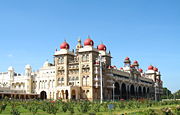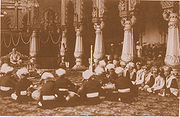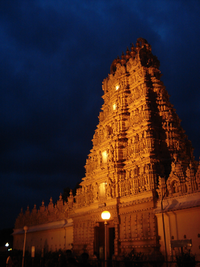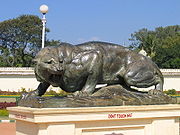
Mysore Palace
Encyclopedia


India
India , officially the Republic of India , is a country in South Asia. It is the seventh-largest country by geographical area, the second-most populous country with over 1.2 billion people, and the most populous democracy in the world...
. It is the official residence of the Wodeyars - the erstwhile royal family of Mysore, and also houses two durbar halls (ceremonial meeting hall of the royal court).
Mysore is commonly described as the City of Palaces, however, the term "Mysore Palace" specifically refers to one within the old fort. The Wodeyar
Wodeyar
The Wodeyar dynasty was an Indian royal dynasty that ruled the Kingdom of Mysore from 1399 to 1947, until the independence of India from British rule and the subsequent unification of the Indian dominion and princely states into the Republic of India.The spelling Wodeyar/Wadiyar is found in most...
kings first built a palace in Mysore in the 14th century, it was demolished and constructed multiple times. The current palace construction was commissioned in 1897, and it was completed in 1912 and expanded later around 1940.
Mysore palace is now one of the most famous tourist attractions in India after Taj Mahal with more than 2.7 million visitors. Although tourists are allowed to visit the palace, they are not allowed to take photographs inside the palace. Price of admission for foreign tourists is 200 INR., and for Indians 20 INR. All visitors must remove their footwear to enter the palace.
The regent of Mysore, Maharani Vani Vilas Sannidhna, commissioned a British architect, Henry Irwin
Henry Irwin
Henry Irwin, a renowned architect of British India was born on 21 January 1841, in Tarbett, County Kerry, Ireland. He is mainly known for his works in Indo-Saracenic style of architecture. He was a member of the Institution of Engineers. He died on 5 August 1922, at Ooty, India...
, to build yet another palace in its place. The construction was completed in year 1912. But slowly the beautification of the fort was also taken up and the inhabitants of the fort were slowly shifted out to newer Extension built outside. The present Public Durbar Hall wing was also added much later around 1940.
Architecture
The architectural style of the palace is commonly described as Indo-SaracenicIndo-Saracenic
The Indo-Saracenic Revival was an architectural style movement by British architects in the late 19th century in British India...
, and blends together Hindu, Muslim
Islamic architecture
Islamic architecture encompasses a wide range of both secular and religious styles from the foundation of Islam to the present day, influencing the design and construction of buildings and structures in Islamic culture....
, Rajput, and Gothic styles of architecture. It is a three-storied stone structure, with marble domes and a 145 ft five-storied tower. The palace is surrounded by a large garden.
The three storied stone building of fine gray granite
Granite
Granite is a common and widely occurring type of intrusive, felsic, igneous rock. Granite usually has a medium- to coarse-grained texture. Occasionally some individual crystals are larger than the groundmass, in which case the texture is known as porphyritic. A granitic rock with a porphyritic...
with deep pink marble domes was designed by Henry Irwin. The facade has seven expansive arches and two smaller ones flanking the central arch, which is supported by tall pillars.
Above the central arch is an impressive sculpture of Gajalakshmi
Gajalakshmi
Gajalakshmi, that is Lakshmi with elephants, is one of the most significant Ashtalakshmi aspects of the Hindu goddess Lakshmi. In this aspect, the goddess is depicted seated on a lotus, flanked on both side by an elephant . She is shown as seated in Padmasana yogic posture, and has four arms...
, the goddess
Goddess
A goddess is a female deity. In some cultures goddesses are associated with Earth, motherhood, love, and the household. In other cultures, goddesses also rule over war, death, and destruction as well as healing....
of wealth
Wealth
Wealth is the abundance of valuable resources or material possessions. The word wealth is derived from the old English wela, which is from an Indo-European word stem...
, prosperity
Prosperity
Prosperity is the state of flourishing, thriving, good fortune and/or successful social status. Prosperity often encompasses wealth but also includes others factors which are independent of wealth to varying degrees, such as happiness and health....
, good luck
Luck
Luck or fortuity is good fortune which occurs beyond one's control, without regard to one's will, intention, or desired result. There are at least two senses people usually mean when they use the term, the prescriptive sense and the descriptive sense...
, and abundance with her elephants.
Special events


Mysore Dasara
Mysore Dasara is the Nadahabba of the state of Karnataka. It is also called Navaratri and is a 10-day festival with the last day being Vijayadashami, the most auspicious day of Dasara. Dasara usually falls in the month of September or October...
festival, during which leading artists perform on a stage set up in the palace grounds. On the tenth day of the festival Vijaya Dashami, a parade with caparisoned elephants and other floats originate from the palace grounds.
Dasara
Mysore Dasara
Mysore Dasara is the Nadahabba of the state of Karnataka. It is also called Navaratri and is a 10-day festival with the last day being Vijayadashami, the most auspicious day of Dasara. Dasara usually falls in the month of September or October...
is the most extravagant festival of Mysore. The Dasara festival is celebrated in the months of September and October of each year.
The festival celebrates and commemorates the victory of the great Goddess Durga
Durga
For the 1985 Hindi Film of Rajesh Khanna see DurgaaIn Hinduism, Durga ; ; meaning "the inaccessible" or "the invincible"; , durga) or Maa Durga "one who can redeem in situations of utmost distress" is a form of Devi, the supremely radiant goddess, depicted as having eighteen arms, riding a lion...
, after she slew the demon, Mahishasura
Mahishasura
In Hindu mythology, Mahishasura was an asura.Mahishasura's father Rambha was king of the asuras, and he once fell in love with a water buffalo ; Mahishasura was born out of this union...
, and thereby, symbolizing the triumph of good over evil according to Hindu mythology
Mythology
The term mythology can refer either to the study of myths, or to a body or collection of myths. As examples, comparative mythology is the study of connections between myths from different cultures, whereas Greek mythology is the body of myths from ancient Greece...
. Some call her Chamundeshwari.
This festival has been celebrated by the Wodeyars at Srirangapatna from 1610 and in Mysore with great pomp from 1799 and the tradition still is carried on although the scale of the celebrations has diminished. The Dasara festivities have become an integral part of the culture and life in Mysore.
To celebrate this festival the Palace of Mysore is illuminated with more than 96,000 lights during that two month period.
Unique rooms


- Ambavilasa
This was used by the king for private audience and is one of the most spectacular rooms. Entry to this opulent hall is through an elegantly carved rosewood doorway inlaid with ivory that opens into a shrine to Ganesha.
The central nave of the hall has ornately gilded columns, stained glass ceilings, decorative steel grills, and chandeliers with fine floral motifs, mirrored in the pietra dura mosaic floor embellished with semi-precious stones.
- Gombe Thotti (Doll’s Pavilion)
Entry to the palace is through the Gombe Thotti or the Doll’s Pavilion, a gallery of traditional dolls from the nineteenth and early twentieth centuries. The pavilion also houses a fine collection of Indian and European sculpture and ceremonial objects like a wooden elephant howdah (frame to carry passengers) decorated with 84 kilograms of gold.
- Kalyana Mantapa
The Kalyana Mantapa or marriage hall is a grand octagonal-shaped pavilion with a multi-hued stained glass ceiling with peacock motifs arranged in geometrical patterns. The entire structure was wrought in Glasgow, Scotland.
The floor of the Mantapa continues the peacock theme with a peacock mosaic, designed with tiles from England. Oil paintings, illustrating the royal procession and Dasara celebrations of bygone years, make the walls more splendid.

Temples
The palace complex includes twelve Hindu temples. The oldest of these was built in the 14th century, while the most recent was built in 1953.Some of the more famous temples are:
- Someshvara Temple, dedicated to God Lord ShivaShivaShiva is a major Hindu deity, and is the destroyer god or transformer among the Trimurti, the Hindu Trinity of the primary aspects of the divine. God Shiva is a yogi who has notice of everything that happens in the world and is the main aspect of life. Yet one with great power lives a life of a...
- Lakshmiramana Temple, dedicated to God Lord VishnuVishnuVishnu is the Supreme god in the Vaishnavite tradition of Hinduism. Smarta followers of Adi Shankara, among others, venerate Vishnu as one of the five primary forms of God....
- Shwetha Varahaswamy Temple, dedicated to Lord Varahaswamy, one of the 10 incarnations of lord Vishnu
and many more.
Attractions

- Audience Chamber: This was Hall of Private Audience, where the king would confer with his ministers. It was also the chamber in which he gave audience to people deserving special attention.
- Public Durbar: The Diwan-e-aam was a public hall where the general population could meet the king at prescribed times with petitions.
- Royal wedding hall
- Armoury: The palace houses an armoury, which contains a collection of different types of arms used by the members of the royal family. These include weapons that were used in the 14th century (lances, cutlasses, etc.), as well as weapons that were used in the early twentieth century (pistols, etc.).
External links
- Official Portal on Virtual Tour of Mysore Palace
- Official website of Mysore Palace / Can take online Ticket for visiting Mysorepalace
- Official Portal on Virtual Tour of Mysore Palace
- Official website for online Ticket booking
- His Highness - Mysore Maharaja - Srikanta Datta Narasimharaja Wadiyar, Scion of the Royal Family - Official Portal
- Official Mysore Tourism Website
- Official Mysore Dasara Website
- Palaces of Mysore
- Virtual Tour of Mysore Palace

